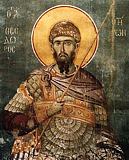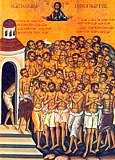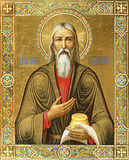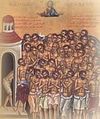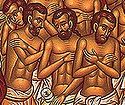

| Previous day | Next day |
| Old Style
March 10
|
Saturday |
New Style
March 23
|
|
1st Week of Great Lent.
Tone 8.
Great Lent. |
Wine and oil allowed.
|
![]() Commemoration of St. Theodore the Tyro (ca. 306).
Commemoration of St. Theodore the Tyro (ca. 306). ![]() The Holy Forty Martyrs of Sebaste: Cyrion (or Quirio), Candidus, Domnus, Hesychius, Heraclius, Smaragdus, Eunoicus, Valens, Vivianus, Claudius, Priscus, Theodulus, Eutychius, John, Xanthias, Helianus, Sisinius, Angus, Aetius, Flavius, Acacius, Ecdicius, Lysimachus, Alexander, Elias, Gorgonius, Theophilus, Dometian, Gaius, Leontius, Athanasius, Cyril, Sacerdon, Nicholas, Valerius, Philoctimon, Severian, Chudion, Aglaius, and Meliton (ca. 320).
The Holy Forty Martyrs of Sebaste: Cyrion (or Quirio), Candidus, Domnus, Hesychius, Heraclius, Smaragdus, Eunoicus, Valens, Vivianus, Claudius, Priscus, Theodulus, Eutychius, John, Xanthias, Helianus, Sisinius, Angus, Aetius, Flavius, Acacius, Ecdicius, Lysimachus, Alexander, Elias, Gorgonius, Theophilus, Dometian, Gaius, Leontius, Athanasius, Cyril, Sacerdon, Nicholas, Valerius, Philoctimon, Severian, Chudion, Aglaius, and Meliton (ca. 320). ![]() Martyr Codratus (Quadratus) and with him Martyrs Cyprian, Dionysius, Anectus, Paul, Crescens, and Dionysius (another), at Corinth (258). St. Paul of Taganrog (1879).
Martyr Codratus (Quadratus) and with him Martyrs Cyprian, Dionysius, Anectus, Paul, Crescens, and Dionysius (another), at Corinth (258). St. Paul of Taganrog (1879).
Martyrs Codratus, Saturninus, and Rufinus, of Nicomedia (3rd c.). St. Anastasia the Patrician, of Alexandria (567-568). St. Alexander (Badanin), priest, of Vologda (1913).
Martyrs Victorinus, Victor, Nicephorus, Claudius, Diodorus, Serapion, Papias, and others, at Corinth (251 or 258). St. Kessog of Lennox (520). St. Attalus, abbot, of Bobbio (626). St. John of Khakhuli, Georgia, called Chrysostom (10th c.-11th c.). New Martyr Michael of Agrapha, at Thessalonica (1544). New Martyr Theodore Sladic of Komogovina, Serbia (1788).
Commemoration of the desert-dwellers of the Roslavl Forests, near Bryansk.
Thoughts for Each Day of the Year
According to the Daily Church Readings from the Word of God
By St. Theophan the Recluse

Saturday. [Heb. 1:1–12; Mark 2:23–3:5]
We have approached the chalice of the Lord, we have been at the Supper of the Lord. Glory to Thee, O God! Glory to Thee, O God! Glory to Thee, O God! Now is the great day of the Lord! The most glorious celebration in heaven! There is no city, nor village, nor house, where there are no people receiving Holy Communion. Across the breadth of Russia, throughout the south and east, so many people clothed in the white garments of justification have tasted of the Divine life, and have most sincerely united themselves with the Lord! The Lord’s Body has been renewed—the Body of the Church, and has been clothed in the glory belonging to it, hidden from the eyes of man, but visible to the eyes of angels. The angels worshipped the First-born when He was brought to the world in His power; now they have worshipped Him because the world has been brought again to Him. They have worshipped Him and sung out: Thy throne, O God, is for ever and ever: the sceptre of Thy kingdom is a right sceptre; Thou lovest righteousness, and hatest wickedness (Ps. 45:6–7).
Articles
 Greatmartyr Theodore the Tyro (“the Recruit”)In memory of this occurrence, the Orthodox Church annually celebrates the holy Great Martyr Theodore the Recruit on the first Saturday of Great Lent. |
 1st Saturday of Great Lent: The Miracle of the Boiled WheatToday we remember the miracle of Saint Theodore the Recruit and the boiled wheat. |
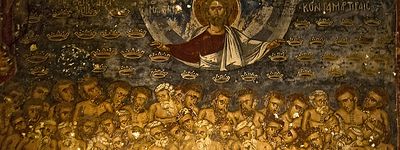 40 Holy Martyrs of Sebaste |
 Martyr Quadratus and those with him at CorinthSaint Quadratus, despite inhuman suffering, encouraged the others, urging them not to be afraid and to stand firmly for the Faith. |
 Saint Anastasia the Patrician of AlexandriaSaint Anastasia the Patrician of Alexandria lived in Constantinople and was descended from an aristocratic family. |
